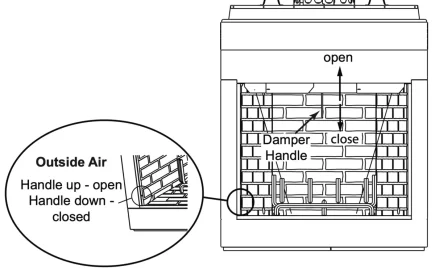It's permissible on some fireplace designs to have it higher.Isn't the combustion air vent supposed to be below the level of the firebox?
Help!😩Smoke Billows in Room! NEW Majestic Biltmore 42”
- Thread starter No More Smoke-Shows:(
- Start date
-
Active since 1995, Hearth.com is THE place on the internet for free information and advice about wood stoves, pellet stoves and other energy saving equipment.
We strive to provide opinions, articles, discussions and history related to Hearth Products and in a more general sense, energy issues.
We promote the EFFICIENT, RESPONSIBLE, CLEAN and SAFE use of all fuels, whether renewable or fossil.
You are using an out of date browser. It may not display this or other websites correctly.
You should upgrade or use an alternative browser.
You should upgrade or use an alternative browser.
brenndatomu
Minister of Fire
I'd have them scope the OAK tubes with a push camera...could very well be one or both are blocked...I recall reading about things like that here more than once. One I remember specifically was the installers stuffed insulation into the partially installed tube to block the air coming in overnight...then forgot to remove it before finishing the install the next day.
joop
Minister of Fire
first off,lighting a fire in august is not going to create much of a draft,see how it behaves when temp drops
brenndatomu
Minister of Fire
first off,lighting a fire in august is not going to create much of a draft,see how it behaves when temp drops
This ^ ^ ^-As for the outside air temperature, this fireplace did the same thing all winter (it was actually in winter we used it for the first time and discovered the problem, and we have very cold winters here in Canada).
joop
Minister of Fire
mellow
Resident Stove Connoisseur
I don't see anyone mention a fan on top of the chimney to help with draft: https://www.rockfordchimneysupply.com/products/auto-draft-chimney-top-ventilator
It is usually a last resort but it sounds like you are there already.
It is usually a last resort but it sounds like you are there already.
The only flue vent system I am familiar with was used to cool the flue , firebox, hood in lue of insulation . This was on an old wall hanging fireplace, zero clearance from the 60's - old think box can't get the system mfg name out. I do know that that particular mfg was bought by a different outfit and then the whole shebang was bought up again. The third party is still in biz making fireplaces.
AT this point I am thinking along the lines of ERV /HRV system interfering with the fireplace, as was mentioned a bit ago. I have an HRV in my place mostly just keep it shut off. ( mandatory install for the time period 1990) Company that made it is no-longer in biz. on mine i have 2 blowers one to remove inside air the other to supply outside air- so to get a positive air pressure in house the intake blower must be set at a higher rate than the exhaust unit. Even with the heat reclaimer/ dehumidifer system in it the unit it causes me to use more energy to heat or cool than with it shut down - also needs an auto damper on the intake to completely seal it when not in use, this unit runs based on humidity factor. As a dehumidifier it sucks big time Not the best design ,that's for sure.
AT this point I am thinking along the lines of ERV /HRV system interfering with the fireplace, as was mentioned a bit ago. I have an HRV in my place mostly just keep it shut off. ( mandatory install for the time period 1990) Company that made it is no-longer in biz. on mine i have 2 blowers one to remove inside air the other to supply outside air- so to get a positive air pressure in house the intake blower must be set at a higher rate than the exhaust unit. Even with the heat reclaimer/ dehumidifer system in it the unit it causes me to use more energy to heat or cool than with it shut down - also needs an auto damper on the intake to completely seal it when not in use, this unit runs based on humidity factor. As a dehumidifier it sucks big time Not the best design ,that's for sure.
Long post, but it was mentionedI don't see anyone mention a fan on top of the chimney to help with draft: https://www.rockfordchimneysupply.com/products/auto-draft-chimney-top-ventilator
-I did ask about adding a fan to the top of the chimney to help with the draw, and was told that it would be against code in our area.
Thanks for the information and comments. To answer the questions:
-There are no other fans in this small detached building, it doesn’t have a second storey and is pretty airtight.
-I’ve attached a couple images that show the height difference between the “Shed” and the main house is not as significant as the diagram shown (thanks for that article by the way, good info!). Also, it’s made no difference if it’s a very calm or very windy day.
-I think it possibly would’ve been better to have the combustion air vent at floor level (from what I’ve read). But I’ve attached a screenshot of the installation manual for this fireplace, and it looks like the raised vent meets the requirements.
-Mirco22, I don’t understand what you mean when you said, “your chimney flue is too short to even have a draft damper, the draft reverses direction!”
A couple questions I have:
1. I’m still not clear on how (without ripping walls apart) I could check for a blockage in this Outside Air Vent? Also, how I could confirm that the “open & closed” mechanism (lever) to this vent is operating properly.
2. Again, excuse my ignorance… But the air that comes in through the outside combustion air vent — I assume it comes in and surrounds the cavity behind the firebrick panels. How does that air filtrate through to the fire? Is it through that inch gap that is just behind the decorative marble mantle surround? I’m confused why I didn’t feel any air coming through there when we had a fan connected to the outside of this vent blowing a significant amount of air through it.
Thanks again!
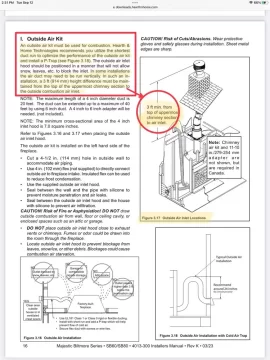
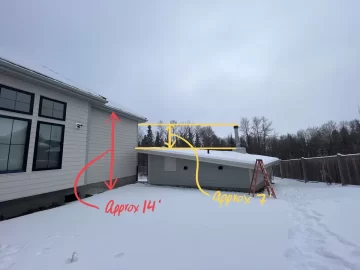
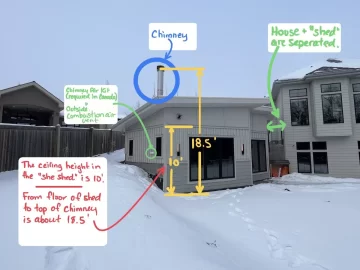
-There are no other fans in this small detached building, it doesn’t have a second storey and is pretty airtight.
-I’ve attached a couple images that show the height difference between the “Shed” and the main house is not as significant as the diagram shown (thanks for that article by the way, good info!). Also, it’s made no difference if it’s a very calm or very windy day.
-I think it possibly would’ve been better to have the combustion air vent at floor level (from what I’ve read). But I’ve attached a screenshot of the installation manual for this fireplace, and it looks like the raised vent meets the requirements.
-Mirco22, I don’t understand what you mean when you said, “your chimney flue is too short to even have a draft damper, the draft reverses direction!”
A couple questions I have:
1. I’m still not clear on how (without ripping walls apart) I could check for a blockage in this Outside Air Vent? Also, how I could confirm that the “open & closed” mechanism (lever) to this vent is operating properly.
2. Again, excuse my ignorance… But the air that comes in through the outside combustion air vent — I assume it comes in and surrounds the cavity behind the firebrick panels. How does that air filtrate through to the fire? Is it through that inch gap that is just behind the decorative marble mantle surround? I’m confused why I didn’t feel any air coming through there when we had a fan connected to the outside of this vent blowing a significant amount of air through it.
Thanks again!



if the combustion air pipe were closed it wouldn't work even with the window open, the fire would die, you have to close the other pipe from the outside, the one that reduces the draft or add other pipes to extend the flue upwards but I don't think is the case
Thanks for the helpful update. If the buildings are completely separate with no hallway or closed breezeway then that eliminates the chimney effect of the other house and as you have pointed out, the lack of fans - outside of the fans in the ERV. However, the location relative to the adjacent building or terrain may still be having an effect. This is from the Biltmore install manual.
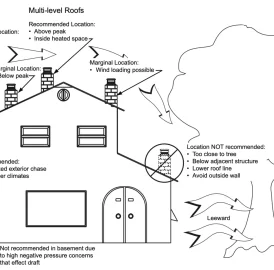
Let's check another assumption - the fireplace burns well and correctly with a nearby window cracked open. Is that correct?
If yes, then if this window is opened the same amount without a fire burning, on a calm cool day, is there still a notable inrush of air? If yes, that indicates negative pressure in the room.
I don't know where the Biltmore introduces the outside air to the fire. It may be in more than one location, but both within the fireplace enclosure. It may be at the base of the firebox on the left side. That's where the outside air connection is. I guess one way to check the outside air connection is to run a camera through it (boroscope). These are pretty common and inexpensive these days. Another method might be to blow smoke into the outside intake with an observer on the inside watching where or if the smoke enters into the fireplace's firebox.

Let's check another assumption - the fireplace burns well and correctly with a nearby window cracked open. Is that correct?
If yes, then if this window is opened the same amount without a fire burning, on a calm cool day, is there still a notable inrush of air? If yes, that indicates negative pressure in the room.
I don't know where the Biltmore introduces the outside air to the fire. It may be in more than one location, but both within the fireplace enclosure. It may be at the base of the firebox on the left side. That's where the outside air connection is. I guess one way to check the outside air connection is to run a camera through it (boroscope). These are pretty common and inexpensive these days. Another method might be to blow smoke into the outside intake with an observer on the inside watching where or if the smoke enters into the fireplace's firebox.
The Biltmore is sold as an open fireplace. Glass doors are an option. In the picture, it looks like the fireplace does not have glass doors, just a fire screen. The fireplace would work fine as long as there is sufficient room air for combustion. This is what is being achieved by opening a nearby window a little.if the combustion air pipe were closed it wouldn't work even with the window open, the fire would die, you have to close the other pipe from the outside, the one that reduces the draft or add other pipes to extend the flue upwards but I don't think is the case
joop
Minister of Fire
@begreen
then it is very necessary check that the combustion air pipe is working, but I believe that even if it works, there will hardly be a minimum draft to avoid smoke, the chimney it is the bare minimum according to the manual, but as there is a draft reducer it is totally insufficient also the fact that the combustion air pipe and draft reducer pipe are practically next to each other, I don't know if it can create problems
then it is very necessary check that the combustion air pipe is working, but I believe that even if it works, there will hardly be a minimum draft to avoid smoke, the chimney it is the bare minimum according to the manual, but as there is a draft reducer it is totally insufficient also the fact that the combustion air pipe and draft reducer pipe are practically next to each other, I don't know if it can create problems
Yes, thus the above suggestions for checking. It could be something as simple as the OAK linkage has become disconnected.
Draft reducer? I thought that was for air cooling the outer jacket of the chimney pipe.
Draft reducer? I thought that was for air cooling the outer jacket of the chimney pipe.
The wording says reduce, not solve all situations. Indeed, there may be a fault in the OAK system or it may be with the ERV and outside of the 4" air supply's ability to remedy. Steps to isolate the cause have been mentioned in this thread.@begreen
on the descrition it says: This feature is designed to reduce the results of continued negative pressure within the chimney.
The owner manual specifically says:
The outside air kit supplies some combustion air for your fireplace. It may help reduce the effects of negative air pressure. The negative pressure in the house can be tested. Whoever set up the ERV should have done this.
this tube on the right, what does he do ? Doesn't it reduce the draft?@begreen
gthomas785
Minister of Fire
I'm also confused about the function of the chimney air kit. Does it introduce air into the flue or into the annular space between the walls of the chimney pipe? Either way, it would have the effect of reducing the draft by cooling the chimney.
The annular space. It's not required in the US. This fireplace uses Majestic SL1100 series 12" wood burning chimney pipe, 11" inner, 13" outer. In the US, the start collar has holes all around to cool the chimney pipe. In Canada, they require an outside air connection to feed those holes. It's just a box plenum with an outside air connection that surrounds the chimney start collar. I guess the concern is that the chase might be made airtight, causing insufficient cooling. I don't think this is related to the problem.I'm also confused about the function of the chimney air kit. Does it introduce air into the flue or into the annular space between the walls of the chimney pipe? Either way, it would have the effect of reducing the draft by cooling the chimney.
This is what it looks like without the chimney air box.
Yes that is a system to cool the flue pipe as there in no insulation between the inner and outer walls. Wether it also cools the external area of the fire box I do not know, likely as that is the design spec. Similar to what was mounted on the wall in 1960 ranch I owned a few years back. The Majestic name kicked my old brain into gear.
11" flue- that is always going to be a problem draft wise unless you build a pretty big fire all the time.
In the 80's I bought a late 50's built ranch. Repo from the bank. ( people think that the 7 or so percent interest rate is bad- back then it was close to 20%) It had a majestic fireplace similar to yours , 13" od-11"id flue. A nice fire in that would suck all the heat out of the house. ( the furnace would actually come on when in use) The facade was covered in soot when I purchased it. it did not have an oak system, I added that, didn't help. I put an insert in it and never looked back. it looked pretty good that way- sure was a pia cleaning all that soot of the field stone facade.
11" flue- that is always going to be a problem draft wise unless you build a pretty big fire all the time.
In the 80's I bought a late 50's built ranch. Repo from the bank. ( people think that the 7 or so percent interest rate is bad- back then it was close to 20%) It had a majestic fireplace similar to yours , 13" od-11"id flue. A nice fire in that would suck all the heat out of the house. ( the furnace would actually come on when in use) The facade was covered in soot when I purchased it. it did not have an oak system, I added that, didn't help. I put an insert in it and never looked back. it looked pretty good that way- sure was a pia cleaning all that soot of the field stone facade.
joop
Minister of Fire
Hi everyone. Yes, I always have that outside air handle in the up/open position. Thanks for the camera suggestion - we have a camera on order to check that there‘s nothing blocking the air intake.
A few things I find strange though…. Even with a BIG fire it will instantly smoke if the window is closed.
Also, please see attached screenshot which shows the room size/dimensions as well as window locations. The other thing I find strange, is that I can have the far window (shown on the plan) wide open, and that’s not sufficient to stop it from smoking. I NEED to have the closer window open. I would’ve thought that if it’s a negative air pressure problem, that having the far window open should correct the air pressure.
Is it worth adding to the height of the chimney even though it’s already at the recommended height? The problem is that I think it would need more support / bracing if it gets any taller.
It had been mentioned to me in the past is that the fireplace is too large for this small space. We’ve already added the smoke shield (which slightly reduced the height of the opening), and that didn’t work. I‘m trying to think of a way I could try “reducing” the width of the opening — just a temporary makeshift way to test if that’s the problem. I thought maybe I could tape something to the stone facing on each side; but not sure what I could tape that wouldn’t be combustable!
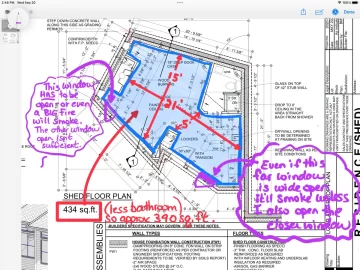
A few things I find strange though…. Even with a BIG fire it will instantly smoke if the window is closed.
Also, please see attached screenshot which shows the room size/dimensions as well as window locations. The other thing I find strange, is that I can have the far window (shown on the plan) wide open, and that’s not sufficient to stop it from smoking. I NEED to have the closer window open. I would’ve thought that if it’s a negative air pressure problem, that having the far window open should correct the air pressure.
Is it worth adding to the height of the chimney even though it’s already at the recommended height? The problem is that I think it would need more support / bracing if it gets any taller.
It had been mentioned to me in the past is that the fireplace is too large for this small space. We’ve already added the smoke shield (which slightly reduced the height of the opening), and that didn’t work. I‘m trying to think of a way I could try “reducing” the width of the opening — just a temporary makeshift way to test if that’s the problem. I thought maybe I could tape something to the stone facing on each side; but not sure what I could tape that wouldn’t be combustable!

Similar threads
- Replies
- 24
- Views
- 2K
- Replies
- 4
- Views
- 1K
- Replies
- 2
- Views
- 1K
- Replies
- 107
- Views
- 10K


